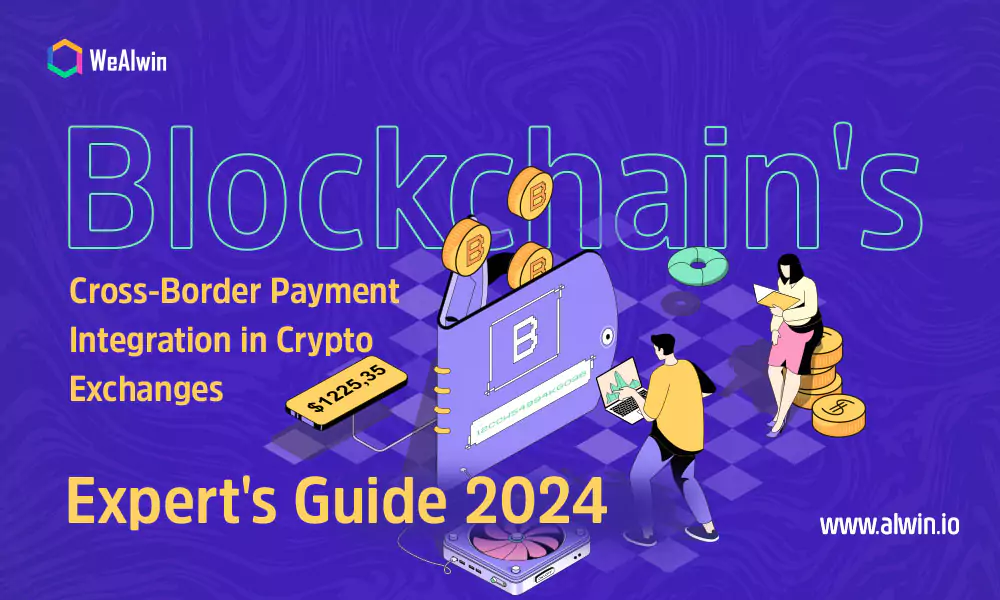Are you tired of the lengthy and complicated process of cross-border payments?
In 2024, the game is changing with blockchain technology. As a business owner or individual, you know the struggles of sending or receiving payments across borders.
But what if we told you there's a solution that's not only efficient but also secure?
That's where blockchain's cross-border payment integration in crypto exchanges comes in.

Let's unwrap this together, shall we?
Blockchain Cross-Border Payments: The Global Transaction Revolution
Blockchain cross-border payments use blockchain technology for quick, low-cost transactions between parties in different countries to facilitate international money transfers. It ensures instant payments, cuts costs, and boosts security through decentralization.
Blockchain's cross-border payment processing achieves nearly instantaneous results, slashing transaction costs by up to 40% - 80%. It implements robust security measures and guarantees end-to-end traceability of payment data.
Evolution of Cross-Border Payments
Have you ever worried about how long it would take for money to reach someone overseas?
That used to be the norm with traditional banking—trustworthy but slow and costly.
Blockchain technology offers a 24/7 operational model, minimal transaction costs, and complete settlement, providing a faster and more secure alternative.
Cryptocurrencies, including stablecoins, present opportunities for swift and cost-effective international payments, minimizing the risks associated with third-party involvement.
Central Bank Digital Currencies (CBDCs) represent another digital currency advancement, issued by central banks and functioning similarly to fiat money.
CBDCs have the potential to enhance efficiency, accelerate settlements, and reduce costs in payment transactions.
The future of cross-border payments is anticipated to feature a coexistence of traditional and blockchain-enabled methods.
Market Trends and Insights
Blockchain is swiftly transforming cross-border payments, expected to grow from $1.6 billion in 2020 to a projected $4.4 billion by 2025, a robust CAGR of 22.6%. This technology drastically cuts costs by 60%, potentially saving banks $16 billion annually.
Transaction times are reduced from days to minutes, ensuring enhanced transparency and security.
In 2024, blockchain is set to dominate B2B payments, with a market share exceeding 40%, reducing transaction costs by around 50% and processing times by 30-40%. Fintech firms are poised to challenge traditional banks in the dynamic B2B cross-border payments market, offering innovative solutions.
Key Statistics
- Cross-border B2B e-commerce is projected to grow 120% from 2023 to 2030, reaching a $22 trillion total addressable market by 2030.
- The global payments industry aims to achieve transparency, focusing on meeting the G20’s Roadmap targets by 2027.
- Significant trends shaping cross-border payments include increased global migration and SME expansion into international markets.
- QR code adoption is anticipated to expand globally, with particular developments expected in Western nations.
- Companies handling cross-border gifts are predicted to gain significant traction in 2024.
What's the Buzz About Shifting Cross-Border Payments onto Blockchain Rails?
Unlike international bank transfers, blockchain significantly reduces transaction processing costs by removing intermediaries (e.g., commercial banks, and clearing houses). Furthermore, there are no cut-off times for payment processing, leading to a substantial increase in processing speed.
In contrast to independent e-payment systems like PayPal or MoneyGram, blockchain ensures enhanced security for sensitive data, eliminating the risk of data leakage. Additionally, blockchain money transfers are fully transparent, fostering mutual trust among payers, payees, and cross-border payment service providers.

How Does Blockchain’s Cross-Border Payment Work?
Blockchain network members or smart contracts automatically handle cross-border payments. The transaction request goes to a peer-to-peer (P2P) network, where nodes validate it using a chosen consensus protocol.

Big financial institutions use permissioned blockchains, restricting access to trusted users with special rights for secure high-value transfers. Fintech companies and SMEs prefer permissionless blockchains for smaller transactions, ensuring financial inclusion and maximum transparency.
After validation, payment data gets encrypted with a hash function and stored in timestamped blocks forming an unchangeable ledger, providing a single truth source for payment tracking. Individuals, businesses, and financial services use blockchain through role-specific web and mobile apps.
Each participant maintains an updated copy of the distributed ledger.
Integrating blockchain solutions involves connecting with financial data marketplaces, accounting software, and business-specific systems.
Additionally, it can link to payment initiation systems like core banking software and payment analytics for analyzing cross-border transactions and payer behavior.
Key Features of Cross-Border Payments
Real-time Processing: Blockchain enables swift, 24/7 cross-border payment processing without intermediaries.
Multi-currency Support: Users can make payments in any cryptocurrency, including popular ones, Central Bank Digital Currencies (CBDCs), and custom cryptocurrencies.
Consensus-based Validation: Cross-border payment transactions undergo rule-based validation and prioritization using the selected consensus protocol on the blockchain.
Automated Recordkeeping: After successful validation, payment transactions and relevant data (e.g., currency exchange rates) automatically receive timestamps and are recorded in the immutable ledger.
Full Traceability: The blockchain ledger allows real-time monitoring and end-to-end traceability of cross-border payments for network members.
Comprehensive Audit Trail: Blockchain maintains an unchangeable record of all activities related to payment documents, including the creation, editing, sharing, and viewing of documents like invoices, receipts, and letters of credit.
Payment Automation: Smart contracts contain rules for triggering and automating specific cross-border payment transactions, such as initiating automated payments to foreign service providers upon service delivery.
Advantages of Blockchain Payment Solutions
Blockchain payment solutions bring several advantages over traditional methods
Optimized Record-Keeping
Blockchain consolidates and streamlines financial data, improving record-keeping accuracy and transparency. It enhances the efficiency of tracking transactions, minimizing errors and discrepancies in financial records.
Enhanced Security
Blockchain technology provides advanced security through encryption and smart contracts. This ensures secure and efficient payment processes, making it resistant to hacking and fraud without a single point of failure or control.
Streamlined Processes
By eliminating third parties, blockchain reduces costs and enhances efficiency in payment processes. This is particularly beneficial for businesses involved in international transactions, allowing them to bypass intermediaries for faster and more cost-effective payments.
Improved Data Transparency
Blockchain enhances transaction transparency, making financial transactions more visible and trustworthy. This increased transparency reduces the risk of fraud and improves accountability, as all transactions are recorded on a public ledger accessible to all network participants.
Cost Savings in International Transactions
Blockchain facilitates low-cost international transactions by bypassing intermediaries and traditional banking infrastructure. This is advantageous for businesses conducting international transactions, leading to savings on transaction fees and faster payment completion.
Smart Contracts Automation
Blockchain enables the use of smart contracts, self-executing agreements with terms directly written into code. This automates contract execution and enforcement, reducing the need for intermediaries and further streamlining payment processes.
Decentralization Advantages
Operating as a decentralized technology, blockchain eliminates the need for a central controlling authority. This reduces the risk of a single point of failure, making the system more resilient to external threats.
Faster Settlement Times
Traditional payment systems take days to settle transactions, whereas blockchain payments can be completed in seconds or minutes. This is particularly beneficial for businesses requiring immediate access to funds.
The Role of Cryptocurrencies in Cross-Border Payments
Cryptocurrencies, like stablecoins and digital currencies, are revolutionizing cross-border payments. They offer quicker, cheaper, and more transparent transactions, disrupting traditional systems.
Central Bank Digital Currencies (CBDCs) enhance efficiency, reduce costs, and promote financial inclusion. Cryptocurrency technology, including tokenization and encryption, improves safety and efficiency.
Blockchain technology enables faster cross-border payments, and the elimination of intermediaries results in lower fees and enhanced security for remittances.
Integration of Cryptocurrencies like Bitcoin in Payment Systems
Cryptocurrency payment gateways actively integrate digital currencies like Bitcoin into payment systems, streamlining transactions between customers and businesses.
These gateways empower merchants to receive crypto payments for goods and services.
They offer advantages such as optimizing checkout pages, ensuring competitive exchange rates, and providing wallets for customers to pay without holding crypto assets on their balance sheets.
Some Popular Cryptocurrency Payment Gateways in 2024
- CoinsPaid: Ideal for high-volume transactions
- Coinbase Commerce: Suitable for newcomers
- PayPal: Designed for personal use
- BitPay: Known for its multi-currency support
- NOWPayments: Valued for customization
- Confirmo: Recognized for quick settlements
These gateways operate as merchants integrate them into their checkout software using user-friendly solutions like plugins, hosted payment pages, APIs, or other tools offered by the gateway service.
Businesses can incorporate cryptocurrency payment gateways on their websites through options like hosted payment pages, plugins/extensions for platforms like Magento and Shopify, or direct API integration into the website's code.
The integration duration varies but usually takes a few weeks, depending on setup and resources.
How Much Can You Save with Blockchain-Powered Cross-Border Payment Solutions?
Blockchain cross-border payments save money, speed up transactions, and increase transparency. Traditional methods are slow and expensive due to intermediaries and complex processes.
McKinsey estimates potential annual savings of $4 billion using blockchain. The current cross-border transaction volume is $600 billion, with fees around 2-10%.
Blockchain reduces costs significantly. Transactions on a blockchain are faster and more efficient, happening in real time or within minutes. It also ensures transparency, reducing fraud and errors.
Experts predict a $1 trillion market by 2024 as more entities adopt blockchain for modernizing payment systems. In conclusion, blockchain transforms global finance, making transactions cheaper, faster, and more accessible.
Benefits of Cross-Border Payment Integration in Cryptocurrency Exchanges
Cross-border payment system Integration into cryptocurrency exchanges has several advantages for businesses entering the world of digital currencies.
Save Money and Boost Efficiency: Businesses can cut costs, improve cash flow, and reach more customers globally by using efficient cross-border payments. By getting rid of banks and payment processors, crypto payments reduce transaction costs and speed up settlements for both users and merchants.
Global Payment Access: Crypto payments let users send and receive money worldwide, making cross-border trade and remittances more secure and private. Cross-border crypto payments eliminate geographical barriers, enabling users to make transactions globally.
Financial Inclusion: Crypto payments extend financial services to the unbanked, allowing those with limited access to traditional banking to participate in the global financial system.
Investment Opportunities: Investing in cryptocurrencies can lead to potential gains over time, offering users a chance for future value development.
Consult with our business experts to Integrate cross-border payments now for a streamlined financial experience! Chat with us on WhatsApp
Key Considerations for Cross-Border Payment Integration
When integrating cross-border payments, it's crucial to focus on key factors for success and efficiency.
Let's break down these considerations
Regulatory Compliance and Legal Issues
- Follow diverse regulatory rules in different places.
- Stick to anti-money laundering (AML) and know your customer (KYC) rules, along with data protection laws.
- Implement strong compliance measures for fast, cost-effective, and legally compliant transactions, reducing the risk of penalties.
Managing Cryptocurrency Volatility
- Address the price changes in cryptocurrencies during cross-border transactions.
- Use risk management strategies like hedging, diversification, and setting appropriate risk limits.
- Monitor market trends, and use stop-loss orders, and advanced risk tools for stable and reliable cryptocurrency transactions.
Importance of Liquidity Management
- Ensure there's enough liquidity for smooth cross-border transactions.
- Use central bank liquidity bridges or other tools for efficient fund flow, reducing delays and extra costs.
Exploring Multilateral Platforms
- Consider centralized payment and settlement solutions on multilateral platforms.
- Streamline compliance processes, cut foreign exchange conversion costs, and manage financial risks.
Cross-Border Payment Integration: Success Stories
Cryptocurrency exchanges are leading the way in making it easier to send money across borders. They use blockchain technology to change how global payments work.
Here's a simple breakdown of how some of these exchanges have succeeded
Coinbase: Coinbase is a popular platform for buying, selling, and storing over 150 cryptocurrencies. It's easy to use and secure, making it a top choice for individuals and businesses dealing with cryptocurrencies. Coinbase also lets users convert their earnings into regular money, making it simple to use in traditional financial systems.
Circle Pay: Circle Pay provides a safe way to transfer money between countries and currencies. It supports U.S. dollars, euros, and British pounds in over 30 countries, making cross-border payments easy. The platform's focus on safety and convenience has made it a trusted option for international money transfers.
Ripple: Ripple is known for its blockchain platform that speeds up cross-border payments. It uses its own cryptocurrency, XRP, and various tools for individuals and businesses, making international transactions faster and more cost effective than traditional banking.
PayPal: PayPal now supports cryptocurrencies like Bitcoin, Bitcoin Cash, Ethereum, and Litecoin. This means users can buy, sell, and hold digital assets within the platform. This integration allows easy movement of cryptocurrency between PayPal accounts and external wallets or exchanges, making cross-border transactions smoother.
BitPay: BitPay is a comprehensive platform for storing and exchanging cryptocurrencies for personal or business use. With global payment support and a focus on user experience, BitPay makes it simpler for individuals and merchants to use digital assets across borders.
Stellar: Stellar uses blockchain technology for low-cost cross-border payments, mobile banking, real-time settlements, and automatic currency exchange. By connecting people and financial institutions through its network, Stellar aims to make financial services more accessible and affordable worldwide.
Future Trends and Developments
The future of finance is undergoing a significant transformation with emerging technologies like Central Bank Digital Currencies (CBDCs) and advancements in blockchain payment systems.
In 2024, we anticipate substantial growth in digital currencies, particularly in cross-border and B2B payments.
Juniper forecasts an extraordinary 213,000% increase in global CBDC transaction value by 2030, highlighting rapid growth upon government adoption.
CBDCs, issued by central banks, come in retail form for public use and wholesale form for selected financial institutions. Developing CBDCs necessitates reliable digital infrastructure, access to electricity, and increased mobile phone accessibility.
With over 90% of central banks globally actively exploring or developing CBDCs, the focus is on retail CBDC issuance. China's Digital Yuan (e-CNY) is a frontrunner, conducting extensive trials and aiming for international reach.
Successful CBDC adoption relies on crucial factors such as promoting benefits through education, technological advancements, security measures, regulatory support, and collaboration among entities like merchants, commercial banks, and payment service providers.
Conclusion
Soon, blockchain and cryptocurrency will revolutionize cross-border payments.
Let's ride this wave together!
WeAlwin offers comprehensive solutions for businesses seeking global expansion and addressing cross-border payment complexities.
WeAlwin also provides cryptocurrency exchange development services to help businesses capitalize on the growing demand for digital currencies.



